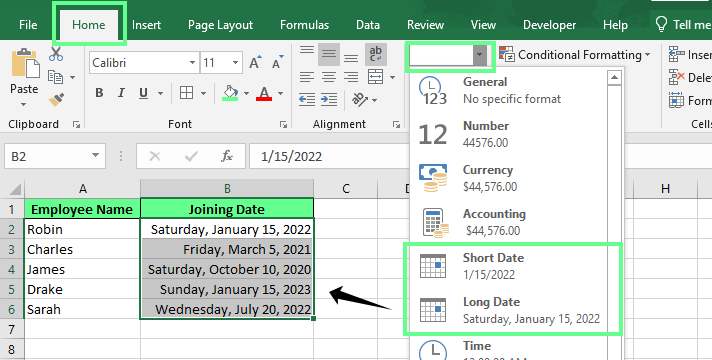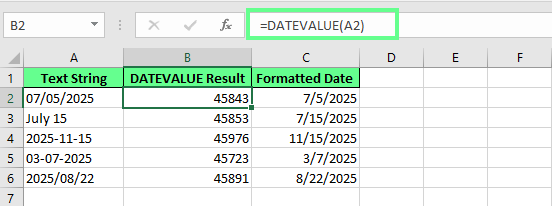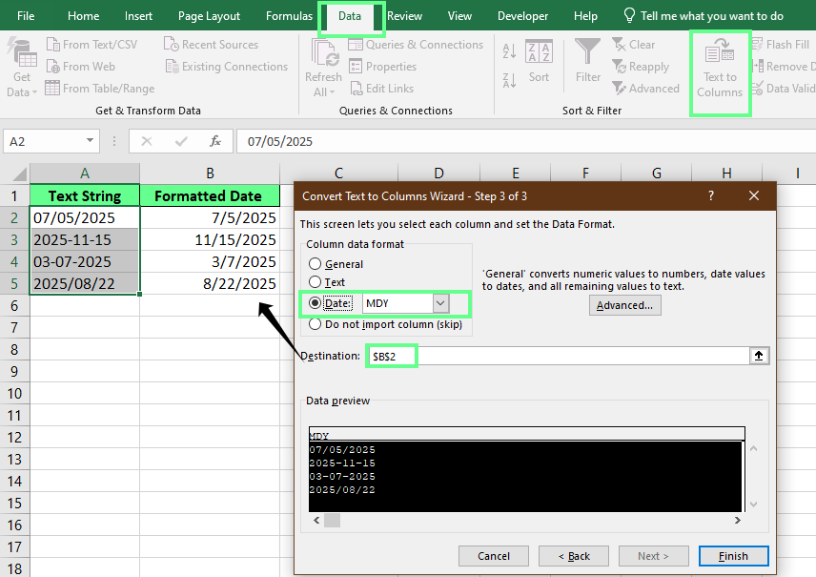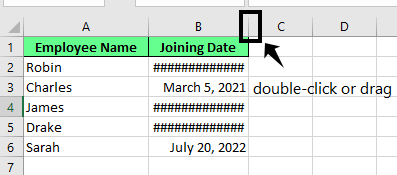Key Takeaways:
- Excel date formatting issues like
#####errors, mixed US/EU formats, and text-converted dates cause data confusion and reporting errors for business users - Excelmatic eliminates the need for complex formatting steps by allowing you to fix date formats using simple language commands
- Compared to manual methods, Excelmatic automatically handles tricky scenarios like text-to-date conversion, regional format conflicts, and custom formatting without formulas
- For professionals working with international teams or multiple data sources, the AI approach ensures consistent, accurate date formatting in seconds
You download a report, open it in Excel, and every date has turned into a five-digit number. Or worse, you're looking at a mix of U.S. and European date formats in the same column.
One says 03/07/2025, and you’re wondering: is that March 7th or July 3rd?
If that’s ever made you question your own data, you're not alone. We've all been there.
Excel is powerful, but its default handling of dates is not always intuitive. In this tutorial, we’ll walk you through the traditional methods for changing date formats in Excel. We'll also introduce a modern, AI-powered approach that lets you skip the tedious steps and get perfect results in seconds.
Understanding Excel's Date Management
Before we fix the problem, it's helpful to understand why it happens. At the backend, Excel has its own way of storing and interpreting dates. If you’re not aware of how it works, you may end up making mistakes when sharing files or working across systems.
Serial number architecture
Excel stores dates as serial numbers. For example, January 1, 1900, is stored as the number 1, January 2, 1900, is 2, and so on. This makes it easy for Excel to calculate things like the number of days between dates.
However, there are two date systems:
- 1900 system: It starts counting from January 1, 1900 (the default on Windows).
- 1904 system: It starts from January 1, 1904, and it’s used mostly on Macs.
If you open a file created with one system on a machine using the other, the dates might shift by about four years. This can cause serious confusion. So if you're sharing workbooks across platforms, check which date system the file uses.
Regional settings integration
Excel follows your computer’s regional settings when displaying dates.
For example, in the U.S., dates are usually written as month/day/year, so 03/07/2025 means March 7, 2025. However, in many other countries, such as the U.K. or Australia, the format is day/month/year. So 03/07/2025 would be read as July 3, 2025.
When you send an Excel file to someone in a different country, the same date in your file may appear differently on their end. That’s why it's best to use clear formats like full month names (e.g., July 3, 2025) when sharing files across regions.
How Excel interprets two-digit years
When we type something like 25 as a year into a date, Excel has to decide whether we mean 1925 or 2025.
By default, it assumes that:
- If the year is between
00and29, it means2000to2029. - If the year is between
30and99, it means1930to1999.
So if we type 4/5/25, Excel will treat it as April 5, 2025. But if we type 4/5/30, Excel will show April 5, 1930. To avoid any ambiguity, we strongly recommend always using four-digit years.
Applying Date Formats: The Traditional vs. The AI Way
If you don’t like the default date format in Excel, you have several ways to change it. Let's look at the standard manual methods first, then see how an AI tool can do it instantly.
The Traditional Way: Manual Formatting
1. Format Cells Dialog Implementation
The Format Cells dialog option is the most common method. Here’s how you use it:
- Right-click on the cell or range of cells with the dates and choose Format Cells. (Or press the
Ctrl+1shortcut). - The Format Cells dialog box will appear. Under the Number tab, click on Date.
- Choose your desired date format from the list and click OK.
You'll see a variety of predefined date formats. The Sample box shows a preview of how your date will look.

2. Home Tab Quick Formatting
You can also use the Home tab for quick formatting:
- Select your cells and go to the Number group on the Home tab.
- Click the dropdown menu.
- Choose Short Date or Long Date.
This is faster, but you only have two basic options. For more control, the Format Cells dialog is better.

The AI-Powered Way: Instantly Format Dates with Excelmatic

Remembering all those steps can be a hassle, especially when you're in a hurry. With an AI agent like Excelmatic, you can skip the clicks and just state your request in plain language.
Here's how it works:
- Upload your Excel file to Excelmatic.
- Type your instruction in the chat box. For example:
- "Change the dates in column B to the format YYYY-MM-DD."
- "Format the 'Ship Date' column as a long date, like 'March 7, 2025'."
- "Make all dates in this sheet use the dd-mmm-yyyy format."

Excelmatic understands your request and applies the correct formatting instantly. There are no dialog boxes to navigate or options to weigh—just a simple command and a perfect result.
Creating Custom Date Formats
If the predefined formats aren't what you need, you can create your own.
The Traditional Way: Using Format Codes
Custom date formats use special codes to tell Excel how to display each part of the date:
| Codes | Display |
|---|---|
| d | day (1–31) |
| dd | two-digit day (01–31) |
| ddd | short day name (Mon, Tue) |
| dddd | full day name (Monday, Tuesday) |
| m | month number (1–12) |
| mm | two-digit month (01–12) |
| mmm | short month name (Jan, Feb) |
| mmmm | full month name (January, February) |
| yy | two-digit year |
| yyyy | four-digit year |
You can combine these codes with delimiters like dashes, slashes, or commas.
To set a custom format:
- Open the Format Cells dialog (
Ctrl+1). - Under the Number tab, select the Custom option.
- Enter your combination of codes in the Type field. For example,
dd-mmm-yyyygives you05-Jul-2025.

You can even add locale codes like [$-409] for U.S. English to ensure the format is consistent across different regional settings.
The AI-Powered Way: Describe the Format You Want
Why memorize format codes? With Excelmatic, you just describe the output you want.
Simply tell Excelmatic:
- "Show the dates in column D as 'Weekday, Month Day, Year'."
- "I need the date format to be '05 July 2025'."
- "Add the day of the week to the current date format in column A."
Excelmatic translates your description into the correct custom format code behind the scenes and applies it for you. This is especially useful for complex formats or when including text, like ="Due on: " & TEXT(A2, "dddd, mmmm d"). You can just tell Excelmatic, "Prepend the text 'Due on:' to the dates in column A."
Managing and Converting Non-Date Entries
One of the biggest headaches is when dates are imported as text. Excel won't recognize them as dates, so you can't sort or format them correctly.
The Traditional Way: Formulas and Wizards
1. DATEVALUE function
This function converts a date stored as text into a real Excel date (a serial number). If cell A2 contains the text '07/05/2025', you would use:
=DATEVALUE(A2)
This returns the serial number 45843. You then have to format this cell back to a date format.

2. Text-to-Columns tool
The Text to Columns wizard is another powerful tool for this conversion:
- Select the column with text dates.
- Go to the Data tab and click Text to Columns.
- Choose Delimited and click Next twice.
- In Step 3, select Date and pick the correct format (e.g., MDY, DMY).
- Click Finish.

The AI-Powered Way: Let AI Handle the Cleanup
Formulas and multi-step wizards are effective, but they're slow and require you to diagnose the problem correctly. Excelmatic makes this process effortless.
Upload your file and simply state the problem:
- "The dates in column C are stored as text. Convert them to actual dates."
- "Fix the date column. It has mixed formats and some are just text."
- "My dates look like 20250705. Please convert them to a standard date format."
Excelmatic intelligently analyzes the column, identifies entries that are text, and converts them into proper Excel dates. It can handle inconsistencies like extra spaces (TRIM), different delimiters (SUBSTITUTE), or non-standard formats automatically, saving you from writing complex nested formulas.
Useful Excel Date Formulas for Managing Dates
Excel has built-in date formulas that can save you time. These are good to know, whether you're working manually or want to understand what's happening behind the scenes.
| Function | Syntax | What It Does |
|---|---|---|
TODAY() |
=TODAY() |
Returns the current date and updates automatically. |
NOW() |
=NOW() |
Returns the current date and time. |
DATE() |
=DATE(year, month, day) |
Combines separate numbers into one valid date. |
TEXT() |
=TEXT(date, format) |
Formats a date exactly the way you want as text. |

With Excelmatic, you can achieve the same results without formulas. For instance, instead of using =TODAY(), you can ask, "Create a new column with today's date."
Troubleshooting Common Date Formatting Issues
Here are some common date-related issues and how to fix them using both methods.
Display and fit errors (#####)
The Problem: A cell shows #####. This means the column is too narrow to display the full date.
Manual Fix: Double-click the right edge of the column header to auto-fit the column, or drag it manually.
AI Fix: Tell Excelmatic, "The date column is showing '#####'. Please fix it." It will automatically adjust the column width.

Import and copy-paste discrepancies
The Problem: You copy data, and dates are treated as text or shift by four years (the 1900 vs. 1904 system issue).
Manual Fix: Use Text-to-Columns or DATEVALUE() for text conversion. For the date shift, go to File > Options > Advanced and check/uncheck Use 1904 date system.
AI Fix: Instruct Excelmatic: "Standardize all dates in this sheet. Some were copied from a Mac and are off by 4 years." The AI can identify and correct the underlying serial numbers.
Locale and system mismatch errors
The Problem: A date like 04/05/2025 is interpreted as April 5th on a U.S. system but May 4th on a U.K. system.
Manual Fix: Use an unambiguous format like dd-mmm-yyyy (e.g., 05-Jul-2025) to avoid confusion. The TEXT() function can enforce this: =TEXT(A1, "dd-mmm-yyyy").
AI Fix: Simply tell Excelmatic: "Ensure all dates are in the DD/MM/YYYY format to avoid confusion with US formats." Excelmatic will parse the existing dates based on their likely original format and standardize them as requested.
Conclusion and Best Practices
Excel’s date formatting quirks can quietly derail collaboration and reporting. Understanding the manual methods—from the Format Cells dialog to functions like DATEVALUE and TEXT—is a valuable skill for any Excel user. It gives you control and helps you understand how Excel works.
However, in today's fast-paced environment, efficiency is key. AI tools like Excelmatic represent the next evolution in spreadsheet management. Instead of navigating menus and remembering formulas, you can simply describe your goal. This not only saves time but also reduces the risk of human error.
Best Practices:
- Always use four-digit years (2025, not 25).
- For collaboration, use unambiguous formats like
dd-mmm-yyyyor the ISO standardyyyy-mm-dd. - For quick, error-free results, leverage an AI tool. Let the machine handle the tedious work of formatting, conversion, and troubleshooting so you can focus on analyzing the data itself.
Ready to simplify your date formatting challenges? Try Excelmatic today and experience the ease of fixing date formats with simple language commands.
Treating date formatting as a deliberate design choice, rather than an afterthought, will keep your spreadsheets clean, reliable, and collaborative.
FAQ
What’s the difference between the 1900 and 1904 date systems in Excel?
The difference between the two systems is 1,462 days, which is about four years (including one leap year). Dates in the 1900 system are always greater than the same date in the 1904 system. If you're working on different computers or sharing files between Windows and Mac, the dates might shift unless both use the same date system.
How do I show just the year with a label like “Year: 2025” in Excel?
You can use a custom number format. Go to Format Cells > Custom and in the Type box, enter "Year: "yyyy". Alternatively, with an AI tool, you could just ask, "Format the dates to only show the year with the label 'Year:'."
How do I convert an 8-digit number into a date in Excel?
8-digit numbers like 23042024 are often treated as text. To convert this in cell A1 to a date in ddmmyyyy format, you can use the formula:
=DATE(RIGHT(A1,4), MID(A1,3,2), LEFT(A1,2))
In this formula:
RIGHT(A1,4)pulls the year (2024)MID(A1,3,2)gets the month (04)LEFT(A1,2)gets the day (23)
With Excelmatic, you could simply say: "The numbers in column A are dates in ddmmyyyy format. Please convert them."






